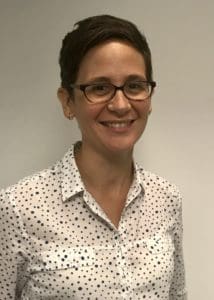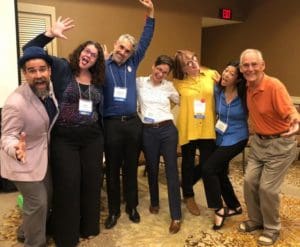Conflict Literacy for Political and Intercultural Dialogues. Member Spotlight: Jessica Baen
Jessica Baen has devoted her whole career to bridging divides, whether interpersonal, professional, or religious as a mediator, advocate, and educator. She holds a Bachelor of Arts in Religious Studies from McGill University and a Master in Public Affairs from Princeton University.
Striving to be Present
 Her mediation philosophy is to “approach mediation and dialogue with a strong faith, and I say this as someone who identifies as agnostic. I couldn’t bear the discomfort of sitting amidst conflict, and all the negative emotions of conflict, without a close to irrational hope. A faith that underneath the accusations, demands, opinions, annoying personalities, myopic vision, and even harmful or selfish behavior, there is a deeply human motivator, something that every one of us can identify with. That ultimately our deepest needs are not in conflict with one another or don’t have to be. We’re a pretty ingenious species.”
Her mediation philosophy is to “approach mediation and dialogue with a strong faith, and I say this as someone who identifies as agnostic. I couldn’t bear the discomfort of sitting amidst conflict, and all the negative emotions of conflict, without a close to irrational hope. A faith that underneath the accusations, demands, opinions, annoying personalities, myopic vision, and even harmful or selfish behavior, there is a deeply human motivator, something that every one of us can identify with. That ultimately our deepest needs are not in conflict with one another or don’t have to be. We’re a pretty ingenious species.”
In her practice, Jessica tries to be present to the participants’ needs and experience – inviting them to dig deep and promising to go down with them – not to recoil at what we find there because of that faith she has – but always letting them lead the way. On some occasions, she uses silence – waiting for something generative to emerge from it – re-centering energy and agency from herself to the participants. Other times she is very active and hands-on. She stated, “I’ll happily nit-pick a miscommunication or other pivotal moment to death if I think we can gain wisdom from fully unpacking it, from uncovering the germ, the root of the divide. Sometimes we find it. Sometimes it’s anticlimactic and we go in circles or feel underwhelmed by the obvious.”
Conflict Resolution in New York
Jessica is a native New Yorker and is grateful for the opportunity to bring her passion for conflict resolution to NYC government. In her position as Conflict Resolution Specialist with the Center for Conflict Resolution at NYC’s Office of Administrative Trials and Hearings, she gets to work closely with people throughout the government, from sanitation to education to law enforcement, pest control. She stated, “It has been fascinating to get glimpses into how such a huge and diverse city functions. Many people are surprised to learn that an office called the Center for Creative Conflict Resolution exists within the city government, which is usually characterized by more formal processes for handling disputes. I think it’s exciting that the city is choosing to make conflict resolution and restorative practices accessible to employees, and also potentially to the public, as we support city agencies to utilize these practices in their outward-facing work.”
Her interest in the field of mediation can be traced, somewhat indirectly, back to reading Tolstoy’s essays on non-violence when she was in high school. She stated, “I met this guy, who later became a Catholic priest, on an 11 hour Amtrak train coming back from a vacation in Montreal. I was reading Anna Karenina and we got to talking, and he recommended I check out Tolstoy’s essays.” She’ll always remember reading these essays for the first time – something resonated. A few years later while she was studying abroad in a Buddhist Studies program in India, she got a chance to hear A.T Ariyaratne speak about the Sarvodaya Shramadana Movement.
She stated, “I began learning about Gandhian nonviolence and, after 9/11 and the beginning of the wars in Iraq and Afghanistan, I became active with the Buddhist Peace Fellowship‘s anti-war protests.” She saw conflict resolution and mediation as ways to build concrete skills to learn to make peace, in addition to protesting the war. She further stated, “the Buddhist Peace Fellowship connected me with a community dispute resolution center in Oakland, the Conciliation Forums of Oakland (renamed East Bay Community Mediation, now SEEDS Community Resolution), which is where I was first trained as a mediator.” She worked there from about 2002 to 2006, first as a volunteer and then as a case manager.
Connection to MBBI
 Later on in her career, she also got involved with Mediators Beyond Borders International (MBBI). She stated, “I had admired MBBI from afar for a while, but first became involved after I met Ken Cloke at a book launch for Politics, Dialogue and the Evolution of Democracy.” Jessica was in the middle of facilitating a political dialogue between Democrats and Republicans. She asked Ken Cloke’s advice about concerns one of the participants had raised. They were a transgender person of color and hesitated to commit to being “civil” (in the context of civil discourse) in the face of possible insults and oppression from Trump supporters. They were afraid of hearing that their anger wasn’t acceptable or welcome. She stated, “I asked Ken’s advice and will forever remember his reply. He said he would have said something like, ‘Please speak your truth, and leave the civility to me.’ We corresponded after that and he graciously granted me permission to quote him in an article I wrote about the dialogues.”
Later on in her career, she also got involved with Mediators Beyond Borders International (MBBI). She stated, “I had admired MBBI from afar for a while, but first became involved after I met Ken Cloke at a book launch for Politics, Dialogue and the Evolution of Democracy.” Jessica was in the middle of facilitating a political dialogue between Democrats and Republicans. She asked Ken Cloke’s advice about concerns one of the participants had raised. They were a transgender person of color and hesitated to commit to being “civil” (in the context of civil discourse) in the face of possible insults and oppression from Trump supporters. They were afraid of hearing that their anger wasn’t acceptable or welcome. She stated, “I asked Ken’s advice and will forever remember his reply. He said he would have said something like, ‘Please speak your truth, and leave the civility to me.’ We corresponded after that and he graciously granted me permission to quote him in an article I wrote about the dialogues.”
Center for Constitutional Rights
After leaving East Bay Community Mediation, she proceeded to take a thirteen-year break from mediation but stayed very connected to the interests that brought her there. Then, during the so-called “War on Terror,” she worked with the Center for Constitutional Rights in their habeas corpus cases for Guantanamo detainees. The term “War on Terror” fell out of common usage with the transition to the Obama administration, but the prison in Guantanamo remains, 20 years later. She stated, “to me, even though it took the form of intense advocacy and activism, and suing the President of the United States, my work with the Center for Constitutional Rights was also a form of conflict resolution. It was about connecting with our ‘enemies’ and trying to advocate for a different, better relationship with the Muslim world.” In her role as a paralegal, she had the opportunity to visit the prison and sit down and speak with men accused of being ‘the worst of the worst.’ She further added, “ I got involved in part to fight the gross human rights violations that occurred there, but also because Guantanamo was so important to international relations, and potentially, peacemaking. I wanted to challenge the way the “War on Terror” was being framed as ‘us’ versus ‘them.” This led me to think about how we were framing our relationship with other cultures. In order to have a different frame, the laws, policies, and culture have to change.”
Facilitating Dialogue
That interest later led her to facilitate intercultural dialogue between young adults in the US and the Middle East with an NGO called Soliya. She noted, “my path back to mediation started with facilitating dialogue and exploring politics, religion, and culture with young adults from the Middle East and the West.” When she returned to the practice of mediation in her current position with the City of New York, she found that the dialogue and facilitation skills she developed in the interim were easily translated to her mediation practice, while the policy and advocacy work she had done informed her interest in promoting the use of conflict resolution and restorative practices within the public sector. During the pandemic, the Center for Creative Conflict Resolution has also supported staff by facilitating support circles around the challenges of living and working through the pandemic, as well as around racial justice and equity in the workplace.
Jessica is currently working on a project with the Center on Religion, Culture & Conflict at Drew University, which brings people together for political dialogue. Before the pandemic, she worked closely to develop a conflict literacy framework for use by social and political organizations.
Life in the Pandemic
During the pandemic, she stated, “it’s been wonderful to see my kid grow over the past year and a half from recent toddler to big kid who wants to be an astronaut and actually knows more about the solar system than I do.” At a personal level, she expressed gratitude for her supportive circle throughout the pandemic, which includes her wife, child, and community of families in her neighborhood in Brooklyn. However, in her day job, she has been very focused on the implementation of Mayor de Blasio’s Executive Order 63, which established the Center for Creative Conflict Resolution as the official dispute resolution resource for the city government. She stated, “We are still in the process of visioning what this will really look like, to support every agency to utilize conflict resolution in their work, and to work towards building a restorative city.” In reference to Executive Order 63, Jessica noted being interested in hearing from other MBBI members who are aware of similar initiatives or projects in other cities or other levels of government.
Article by Elizabeth Gamarra, MBBI Writer
